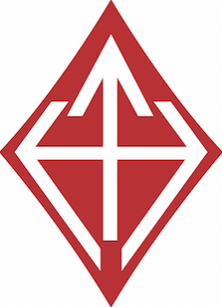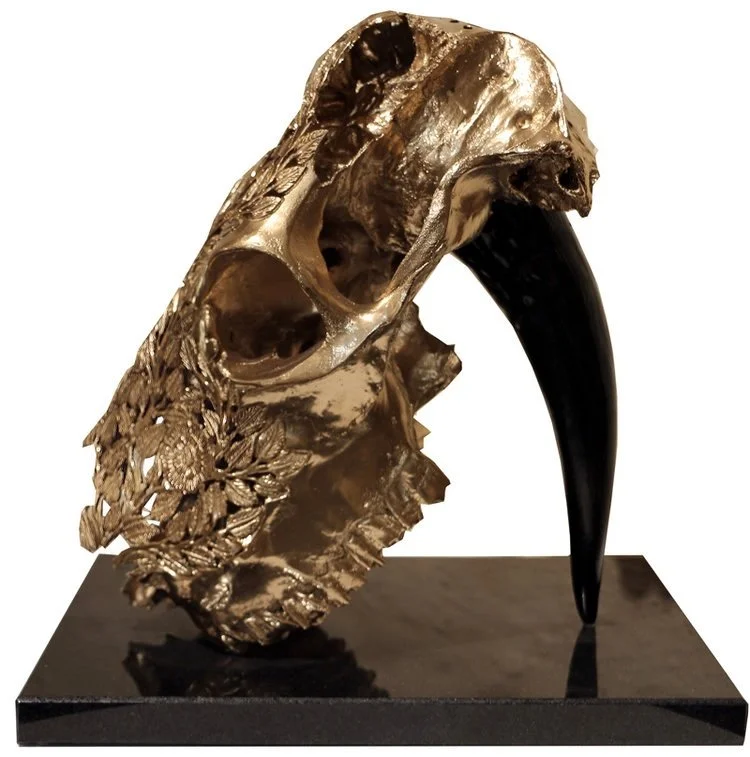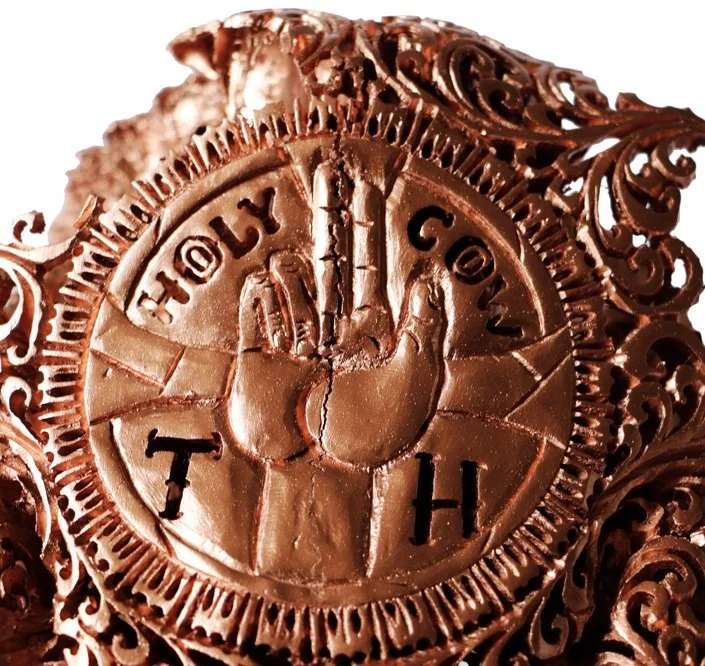STILETTO (2023-2017)
The emergence of the "Stiletto Series" alongside the installation "Holy Cow" showcases Tom Herck's exploration of symbolism and themes related to life, death, and transience, drawing inspiration from historical traditions and incorporating contemporary commentary.
The cow skulls featured in the "Holy Cow" installation serve as a powerful visual metaphor for the cycle of life and death. While skulls are often associated with death, they also carry significance in various cultures as symbols of rebirth and new beginnings. This duality is reflected in Herck's works, inviting viewers to contemplate the fleeting nature of existence and the inevitability of mortality. The inclusion of the Latin phrase "Et in Arcadia ego" and the concept of "Vanitas" further emphasize the theme of impermanence and the emptiness of worldly pursuits.
The incorporation of contemporary elements, such as the stiletto, adds layers of meaning to the series. The stiletto, symbolizing both erotic femininity and power, introduces themes of vanity, vulnerability, and societal obsession with appearances. By juxtaposing the stiletto with the skull, Herck creates a juxtaposition of life and death, desire and emptiness, offering a commentary on the superficiality of modern culture and the pursuit of fleeting pleasures.
Herck's deliberate choice of materials, such as gilded bronze or black skulls placed on a granite surface, demonstrates his attention to detail and symbolic intention. The use of the skull as a starting point for artistic exploration allows him to delve into themes of destruction and vanity, while the reflective qualities of the granite surface contribute to the contemplative nature of the artworks.
The artist's willingness to embrace randomness and relinquish control in his creative process adds an element of unpredictability and authenticity to his work. This approach aligns with the broader themes of impermanence and the acceptance of life's uncertainties.
In essence, the "Stiletto Series" showcases Tom Herck's ability to infuse traditional symbolism with contemporary relevance. By incorporating elements from art history, cultural traditions, and modern society, Herck creates a thought-provoking dialogue about life, death, and the pursuit of meaning in a rapidly changing world.
Stiletto gold
2020
Gilded cow skull 27 cm.
Cow horn.
Black polished granite 20 x 30 cm.
Stiletto gold
2018
Gilded cow skull 27 cm.
Cow horn.
Black polished granite 20 x 30 cm.
Stiletto black
2023
Gilded cow skull 27 cm.
Cow horn.
Black polished granite 30 x 30 cm.
Stiletto gold
2023
Gilded cow skull 27 cm.
Cow horn.
Black polished granite 30 x 30 cm.
Stiletto black
2023
Gilded cow skull 27 cm.
Cow horn.
Black polished granite 30 x 30 cm.
Stiletto gold
2023
Gilded cow skull 27 cm.
Cow horn.
Black polished granite 30 x 30 cm.
In The Holy Trinity we see God as three entities: the Father, the Son and the Holy Spirit typified by a pigeon, Lamb, and hand of God placed on a granite surface modelled in the shape of a church façade, favoured for its mirroring effect. For his latest Stilettos (2018) - equally featuring a Holy Trinity- Herck studiously opts for red copper. In the Bible the coulour red represents blood as well as purification through fire.
Faber Birren, one of the most prominent scolars in the theory of colour, wrote this striking description: “At once, red is the passionate and ardent hue of the spectrum, marking the saint and the sinner, patriotism and anarchy, love and hatred, compassion and war.”
The blood of Christ in Christian theology refers to the physical blood actually shed by Jesus Christ primarily on the Cross, and the salvation which Christianity teaches was accomplished thereby. The Catholic Church teaches that the bread and wine, through transubstantiation, become the body, blood, soul and divinity of Christ —in other words, the whole Christ— when consecrated.
Devotion to the Precious Blood was a phenomenon of Flemish piety in the fifteenth and sixteenth centuries, that gave rise to the iconic image of Grace as the Fountain of Life, filled with blood, pouring from the wounded Lamb of God or the Holy Wounds of Christ. The blood of Christ is a compelling artistic symbol of His incarnation and sacrifice. Red has a more personal association then any other colour, so it may be said that red the the colour of (divine) love. The early Christian theologist and philosopher St.Augustine of Hippo found that the Holy Trinity consists of the lover, the beloved, and the love.
Herck`s Holy Trinity consists of the following symbols: on the lower left Christ, God in the centre, placed higher, and to the right the Holy Spirit. The three skulls indicate the blessing movement (signum crucis in Latin), tracing the shape of a cross in the air or on one's own body, echoing the Christian crucifixion narrative.
While the Trinity is `One`, the divine persons are really distinct from one another and often placed in hierarchical order. Tom therefore chose to create a larger skull to represent God, the other two skulls to the left and right are smaller in size, and show more traces of destruction.
The Holy Trinity
2018
Coppered cow skulls.
Cow horn.
Black polished granite 2 x 70 x 37 cm.
The Holy Trinity
2018
Detail "The Holy Ghost".
The Holy Trinity
2018
Detail "The father".
The Holy Trinity
2018
Detail "The son".
A new phase in the Stiletto series will be marked by an exploration of the human skull and bone -as a universal theme of war and death-, interacting with the cow skull. The Totenkopf, German skull-and-crossbones, was the perfect sigil for the SS. National Socialism took it as a dark, foreboding symbol of courage and self sacrifice, built upon two centuries of traditional use in the German military, dating to the reign of Friedrich the Great himself.
Destruction plays an immense role in contemporary art as rebellion or protest, as spectacle and release, or as an essential component of re-creation and restoration. Nietzsche's announcement in the 19th century that God is dead was significant in art's 'Big Bang'. In recent years, art often reflects life in the age of terrorism and destructive images shoot across the Internet at such incredible speeds that we see so much of this every day. Extreme examples of artists destroying their own work are John Baldessari’s Cremation project (1970), burning 13 years’ worth of 'boring art' he’d made and of course Ai Weiwei’s Dropping a Han Dynasty Urn (1995).
Stiletto bronze
2018
Bronze.
Cow horn.
Stiletto bronze
2018
Bronze.
Cow horn.
Stiletto bronze
2018
Bronze.
Cow horn.
Stiletto bronze
2018
Bronze.
Cow horn.
© Text by Lara van Oudenaarde.
© Photos by Tom Herck.














